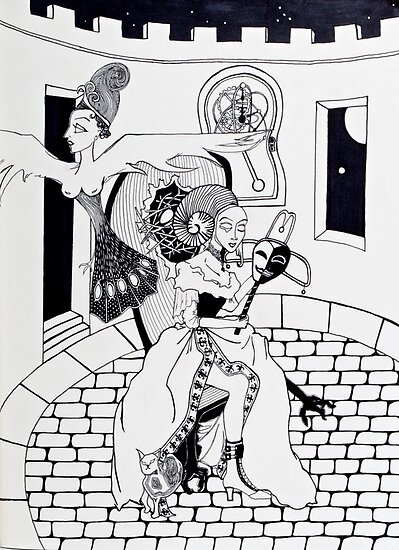If you're lucky enough to be in Wales, there is a fantastic show at Y Tabernacl: MoMA Wales called
Art for Children.
(Monoprint by Charles Shearer, Asleep in your Wake.
Mari Lwyd,pottery by Meri Wells, whose work is also in the show.
also by Meri Wells
An artist I've written about here before, Clive Hicks-Jenkins, has a huge, gorgeous piece in the show called "My Dream Farm," a stretch of magical land in vivid reds and blues, complete with a windmill for those who wish to tilt. On his
artlog, Clive showed glimpses of the image as he worked and talked about the process:
"I'm having a lot of fun with this. Flocks of sheep, horses, cattle, chickens and geese will add life once the environment has been completed. It's a landscape with plenty of routes that can be travelled in imagination, with roads winding through forests and over distant hills, bridges arching over water and a jetty with a little boat tethered ready for a rowing trip. It's just the kind of landscape I'd have enjoyed as a child, and it's been a delight to plan it."
Clive Hicks-Jenkins, My Dream Farm
(This is a "panorama" painting. I will show it in three segments below, because of the woeful 400px restriction here).
Clive often flattens his landscapes, bringing everything to the fore, giving what some leave as mere background scenery just as much immediacy and importance in his paintings as the figures, and his paintings always hold stories within. On his dream farm, he has also done this with the landscape, tilting it forward, pushing it towards you, reminding you that the point is for you to enter and begin your own travels within.
(left detail)
(middle detail)
(right detail)
It is not just a story you enter when you view one of his paintings; it's a life, a motion of high emotion, an experience which leaves you a different person. There are many examples to choose from, which you can see on his
website, but one in particular struck me powerfully today, so I'll share it here.
Clive has painted several versions of St. Kevin and the Blackbird, a series to accompany the poem of the same name by Seamus Heaney:
Saint Kevin and the Blackbird
And then there was St Kevin and the blackbird.
The saint is kneeling, arms stretched out, inside
His cell, but the cell is narrow, so
One turned-up palm is out the window, stiff
As a crossbeam, when a blackbird lands
and Lays in it and settles down to nest.
Kevin feels the warm eggs, the small breast, the tucked
Neat head and claws and, finding himself linked
Into the network of eternal life,
Is moved to pity: now he must hold his hand
Like a branch out in the sun and rain for weeks
Until the young are hatched and fledged and flown.
And since the whole thing’s imagined anyhow,
Imagine being Kevin. Which is he?
Self-forgetful or in agony all the time
From the neck on out down through his hurting forearms?
Are his fingers sleeping? Does he still feel his knees?
Or has the shut-eyed blank of underearth
Crept up through him? Is there distance in his head?
Alone and mirrored clear in Love’s deep river,
‘To labour and not to seek reward,’ he prays,
A prayer his body makes entirely
For he has forgotten self, forgotten bird
And on the riverbank forgotten the river’s name.
--Seamus Heaney

Clive Hicks-Jenkins
Tender BlackbirdIn all of the images, he emphasizes the cramped conditions, the physical discomfort of the saint as he remains, still as a tree, for the bird to complete the nest for its eggs, and then for the eggs to hatch. Either by rendering the wall of his hermitage invisible, so that we can see the contrast between the small quarters and the landscape outside, or by "cropping" the image so that, again, the saint overfills his space, all elbows, and twisting his head to fit, Clive makes the difficulties of the saint's predicament clear. But when I looked back through his preparatory drawings today, something else stood out.



In all of the studies, you can see the strong build of his saint. He is tall and muscular, and yet, despite that, he has ended up in this completely cramped, tiny space, unable to move. Yet he is patient and shows no anger. More than that, if we think of birds as symbolic of the soul and of transcendence, we see that despite the saint's cramped condition, his patience and love for
his own soul means that this is not a time of compression, but rather a time of gestation. His stillness, his inward focus and peace gives the bird the stability and security it needs to give birth, to transcend. And in the end, the eggs hatch, and the baby birds give flight as well. And so his soul is even greater, even more. The quarters and lifestyle are not about denial or self-denial. They are about love, and focus, and flight...
Clive Hicks-Jenkins St. Kevin and the Blackbird































